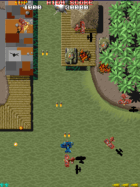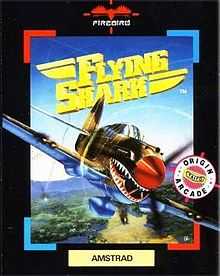Flying Shark
| Flying Shark | |
|---|---|
 North American arcade flyer of Sky Shark | |
| Developer(s) | Toaplan Banana Development Catalyst Coders Firebird Graftgold Images software kaneko Software Creations |
| Publisher(s) |
|
| Composer(s) | Tatsuya Uemura |
| Platform(s) | Arcade
|
| Release date(s) | |
| Genre(s) | Scrolling shooter |
| Mode(s) | Up to 2 players, alternating turns |
| Cabinet | Upright |
| Display | Vertical, Raster, standard resolution |
Flying Shark (飛翔鮫 Hishōzame) is a 1987 vertical scrolling shooter arcade game developed by Toaplan and published by Taito. It was later in the United Kingdom by Electrocoin and in Italy by Model Racing. It was published in North America by Romstar under the name Sky Shark.
In 1989, the game received a sequel titled Shark! Shark! Shark!.
Gameplay

Piloting a biplane, the player takes out enemy land, air, and naval craft across various environments. Certain waves of enemy airplanes produce bonuses when shot down, such as powerups, point bonuses, and extra lives. Each stage begins and ends at a runway, and every time the player lands at a runway beyond the first takeoff, the amount of bombs multiply 3,000 points to the player's total score. The player gets 3 bombs at the start of each stage (or death). The game has five stages and then it loops from stage two indefinitely.
Ports

This game was converted to the Amiga, Commodore 64, MS-DOS, ZX Spectrum, Amstrad CPC, Atari ST, X68000, FM Towns, and Nintendo Entertainment System. The NES version of the game was Tim Follin's first composed soundtrack on the Nintendo Entertainment System.
Much of the ports were only released in Europe or North America, while few were released in Japan. Unlike this game, this game's sequel contains less home ports than this game does.
References
- ↑ "Arcade Release Date". Retrieved 2013-11-06.
- ↑ 2.0 2.1 "Commodore 64 Release Dates". Retrieved 2013-11-06.
- ↑ "ZX Spectrum Release Date". Retrieved 2013-11-06.
- ↑ "Amiga Release Date". Retrieved 2013-11-06.
- ↑ "Amstrad CPC Release Date". Retrieved 2013-11-06.
- ↑ "Atari ST Release Date". Retrieved 2013-11-06.
- ↑ "Nintendo Entertainment System Release Date". Retrieved 2013-11-06.
- ↑ "MS-DOS Release Date". Retrieved 2013-11-06.
- ↑ "PC Release Date". Retrieved 2013-11-06.
External links
- Flying Shark at the Killer List of Videogames
- Flying Shark at World of Spectrum
- Sky Shark reviews at Solvalou.com